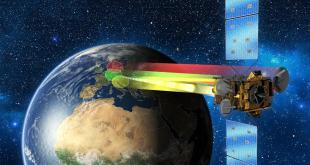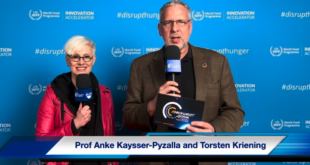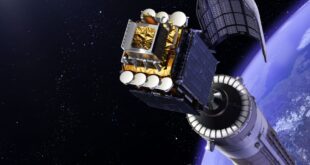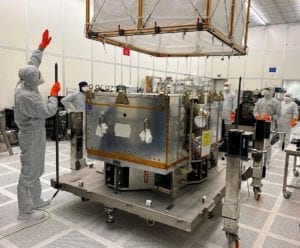
The name of the satellite mission speaks for itself: EnMAP, short for “Environmental Mapping and Analysis Program”, is intended to produce extended and in-depth findings about the state of and changes in ecological systems on land and water using new types of global data sets. The purpose of the EnMAP project, which is being funded by the German Federal Ministry of Economic Affairs and Energy and executed by OHB on behalf of the Space Administration of the German Aerospace Center (DLR RFM) under grant number 50 EP 0801, is to analyze the solar radiation reflected off the Earth’s surface from orbit in a range from visible light to short-wave infrared. But first it must prove its suitability for operation in space: The complex optical instrument has already successfully passed functional, vibration and sound tests.
“EnMAP is the first German hyper-spectral satellite mission and is aimed at studying a wide part of the ecosystem on the Earth’s surface,” explains Marco Fuchs, CEO of OHB System AG, which is developing and building the satellite under contract to the German Aerospace Center (DLR) and with funds provided by the German Federal Ministry of Economic Affairs and Energy. “I am very proud that we can use our expertise to provide scientists with a global view of the Earth as a system to collect information on climate change and the state of nature and the environment.”
A TASTE OF SPACE
The hyperspectral instrument (HSI) for the EnMAP satellite will be spending the next few weeks in IABG’s space testing center to undergo the environmental testing campaign to determine whether it will be able to survive the conditions prevailing in space. The demands are correspondingly high and include testing in the acoustic laboratory (Can the test object withstand the loads occurring during launch and the journey into space?), a thermal-vacuum test campaign in a space simulation chamber (Is full functionality preserved even under the harsh conditions of space?) and an EMC test (Are requirements with respect to electromagnetic compatibility satisfied?).
Following the completion of the environmental test campaign and after the EnMAP instrument has returned to OHB’s space center “Optics & Science” in Oberpfaffenhofen near Munich, integration on the platform, known as the satellite bus, will commence. The EnMAP satellite will then start taking shape. At the end of 2021, the “environmental scout” is to be launched to its destination in a sun-synchronous orbit around the Earth at an altitude of around 640 kilometers. The mission is to have a duration of five years. As the industrial prime contractor, OHB System AG is responsible for developing, manufacturing and testing the complex instrument as well as the entire satellite and is also in charge of launching the satellite.
WHY HYPERSPECTRAL?
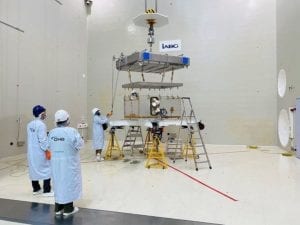
“Multispectral instruments provide data on land cover and distribution, for example. The type of vegetation can also be determined using multispectral measuring methods, allowing conclusions to be drawn about land use,” says Peter Honold, OHB project manager for EnMAP. “This can be supplemented with quantitative information by using the comparatively high-resolution spectral data obtained from a hyperspectral sensor. It shows, for example, the extent to which crops are supplied with nutrients or indicates the quality of the water in lakes.”
The new type of global data collected by the EnMAP mission will be of interest not only in geology, soil science, forestry and agriculture but also in coastal and inland water research. Satellite-based measurements can be performed frequently and repeated regularly over a target area. “We have designed the hyperspectral sensor of the EnMAP satellite in such a way that a 30-kilometer wide strip of the Earth’s surface can be tracked with a spatial resolution of 30 x 30 meters. It is possible to record a strip with a length of 1,000 kilometers per orbit and 5,000 kilometers per day. After four days, EnMAP can fly over a certain location again and generate hyperspectral data sets,” explains Peter Honold.
FURTHER OHB PROJECTS FOR CLIMATE AND WEATHER MISSIONS IN THE PIPELINE
“We have recently been commissioned by the European Space Agency ESA as industrial prime contractor for the two satellites for the CO2M*) Copernicus mission. This mission will be targeting carbon dioxide, which is a harmful greenhouse gas, by taking measurements in the Earth’s atmosphere,” reports OHB’s CEO Fuchs. “It is important to understand the carbon cycle more closely to achieve stable climate modelling in the future and to advance research into and monitoring of climate change. Hyperspectral sensors of the type fitted to EnMAP can supplement this data with analyses of the sunlight reflected from the Earth’s surface. Fortunately, this OHB expertise is also required in the development of the future Copernicus mission CHIME**): We have been designated by Thales Alenia Space to develop and realize the hyperspectral CHIME instrument.”
The German ESA astronaut Alexander Gerst could not have put it more succinctly: “We don’t have a Planet B.” It is precisely the knowledge gained with space technology that clearly shows that global data and efforts are needed if we want to protect our hospitable blue planet. “The preservation of our home planet is close to all our hearts,” says Marco Fuchs in summary. “For this reason, it is of particular importance and extremely motivating for the project teams at OHB and myself to be able to work on powerful instruments and satellites for climate, weather and environmental observation.”
* CO2M: CO2 Monitoring Mission
** CHIME: Copernicus Hyperspectral Imaging Mission for the Environment


